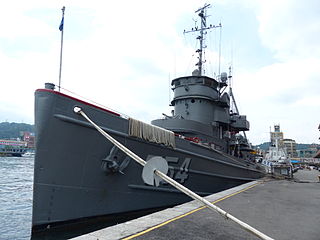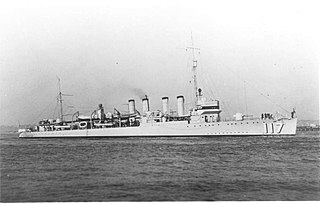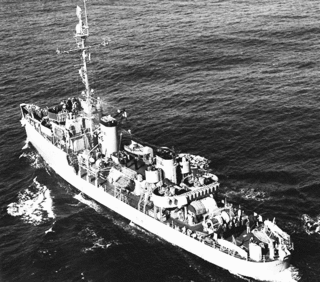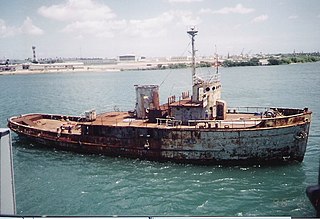
USS Achomawi (AT-148/ATF-148) was an Abnaki-class fleet ocean tug in the service of the United States Navy, and was named for the Achomawi tribe of Native Americans.

USS Dorsey (DD–117), reclassified DMS-1 on 19 November 1940, was a Wickes-class destroyer in the United States Navy during World War I. She was named for John Dorsey.

USS Pakana (AT–108) was an Abnaki-class fleet ocean tug. It was named after the Pakana, a Native American tribe of Texas. This ship saw service in the Pacific theater of World War II, and was later transferred to the United States Bureau of Mines for use in Alaska before being deliberately sunk in 1975.

USS Salish (ATA-187) was a Sotoyomo-class rescue tug of the US Navy. Her hull was laid down on 29 August 1944. She left US service on 10 February 1972 and was recommissioned in the Argentine Navy on the same day as the ARA Alférez Sobral (A-9).

USS Defense (AM-317) was an Auk-class minesweeper acquired by the United States Navy for the dangerous task of removing mines from minefields laid in the water to prevent ships from passing.

USS Starling (AM-64) was an Auk-class minesweeper acquired by the United States Navy for the dangerous task of removing mines from minefields laid in the water to prevent ships from passing.
USS Keosanqua (ATA-198) was a Maricopa-class auxiliary fleet tug of the United States Navy. The ship was authorized as Rescue Ocean Tug ATR-125, and redesignated Auxiliary Fleet Tug USS ATA-198 on 15 May 1944. The ship was laid down at Levingston Shipbuilding Co., Orange, Texas, launched on 17 January 1945, and commissioned on 19 March 1945. She was named Keosanqua (ATA-198) on 16 July 1948.

The USS Coucal (ASR-8) was a Chanticleer-class submarine rescue ship in the United States Navy.

USS Chickasaw (AT-83/ATF-83) was a Navajo-class fleet tug constructed for the United States Navy during World War II. She served in the Pacific Ocean in World War II and the Korean War, and was awarded six battle stars for World War II and two battle stars during the Korean War.

USS Lipan (AT-85) was a Navajo-class fleet tug constructed for the United States Navy during World War II. Her purpose was to aid ships, usually by towing, on the high seas or in combat or post-combat areas, plus "other duties as assigned." She served in the Pacific Ocean during World War II and the Korean War. She was awarded two battle stars for World War II and four battle stars for the Korean War.

USS Tunica (ATA-178) was a Sotoyomo-class auxiliary fleet tug acquired by the United States Navy for service during and after World War II.

USS Current (ARS-22) was a Diver-class rescue and salvage ship commissioned by the U.S. Navy during World War II. Her task was to come to the aid of stricken vessels.
USS Wateree (ATA-174), the third ship named USS Wateree, was a Sotoyomo-class auxiliary fleet tug in the service of the United States Navy during World War II. She later served with the Military Sea Transportation Service and the Peruvian Navy as a diving support ship. In Peruvian naval service she was renamed BAP Unanue (ATA-136).

USS Koka (ATA-185) was a US Navy tugboat. Koka is from the phonetic spelling of Coca, formerly an Indian village in southern Arizona. Originally designated as ATR-112, she was redesignated as ATA-185 on 15 May 1944; launched 11 September 1944, by Levingston Shipbuilding Co., Orange, Texas; and commissioned on 16 November.
USS Arapaho (AT-68/ATF-68) was a Navajo-class fleet ocean tug which served the U.S. Navy during World War II with her towing services. She was assigned initially to support the U.S. Atlantic Fleet, and was eventually assigned to support Allied forces in the war zones of the Pacific Ocean, resulting in her crew returning home after the war with four battle stars to their credit.

The third USS Tillamook (ATA-192), originally USS ATA-192, a United States Navy tug in service from 1945 to 1971.

ATA-190, originally projected as ATR-117, was laid down on 29 September 1944 by the Levingston Shipbuilding Co., Orange, Texas; launched on 26 October 1944; and commissioned on 1 January 1945.

The second USS Stallion was laid down on 26 October 1944 at Orange, Texas, by the Levingston Shipbuilding Co. as ATA-193; launched on 24 November 1944; and commissioned on 1 February 1945.

ATA-197 was laid down on 4 December 1944 at Orange, Texas, by the Levingston Shipbuilding Co.; launched on 6 January 1945; and commissioned on 15 March 1945.

The USS Pinola (ATA-206) was a Sotoyomo-class auxiliary fleet tug launched in 1945 and serving until 1956. The ship was transferred to the Republic of Korea in 1962.

















